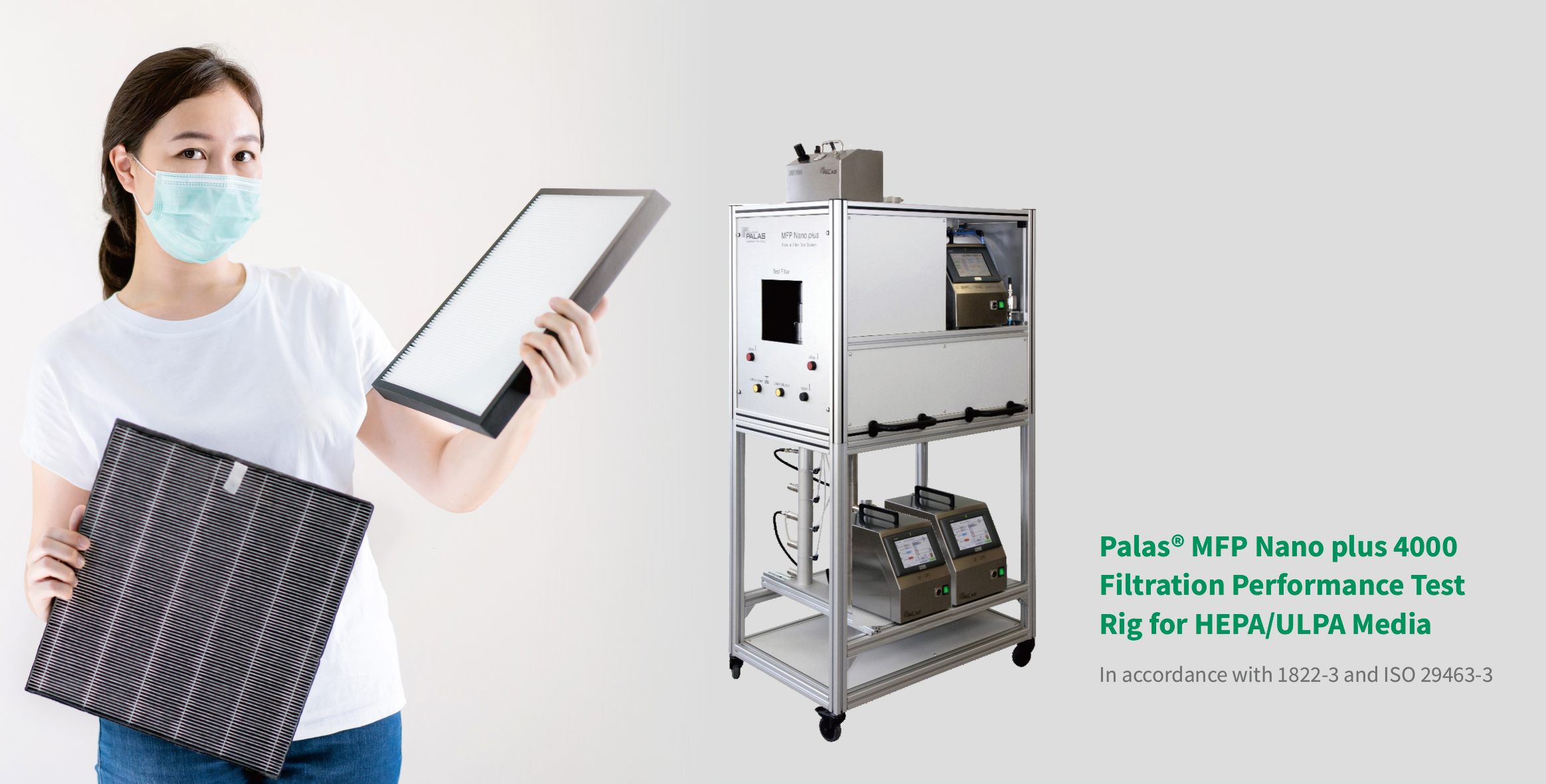The air filtration industry has always focused on standardization of testing, and ISO 29463, issued by the International Organization for Standardization, has set higher standards for testing and classification of HEPA and ULPA filters. With its preciseness and high-quality, Palas® MFP Nano plus 4000 provides internationally comparable measurements in accordance with ISO 29463-3 and DIN EN 1822-3, helping industry suppliers test the performance of their filter media.

Industrial standard ISO 29463
The International Organization for Standardization (ISO) formally promulgated the worldwide standard ISO 29463 “High-efficiency filters and filter media for removing particles in air” in 2011. The standard covers filter classes, filter media test, element leakage test, element efficiency test and measuring requirements for testing. ISO 29463-3 specifies the testing at the flat filter materials. It requires the completion of an initial classification efficiency test, and determines the location of the MPPS (most penetrating particle size in µm) based on the classification efficiency curve. Also for more accurate determination of MPPS, ISO 29463-3 proposes a minimum of six size classes in the MPPS range (i.e., within the 50% MPPS – 150% MPPS interval). And the standard requires reliable downstream measurement data, which sets a higher standard for the filtration industry.

At least 6 size classes in the MPPS range
Palas® respond to high industry standards
Palas® MFP Nano plus 4000 test rig meets industry standard ISO 29463-3. It supports that the particle size distribution of aerosol generator can cover the corresponding MPPS range through proper adjustment of solution concentration, so as to measure MPPS more accurately.

Before and after adjusting the DEHS particle size range to the MPPS range
The MFP Nano plus 4000 provides reliable measurement data. It enables the measurement of graded filtration efficiency in the MPPS range and the entire particle size monitoring range. In addition, the corresponding pressure drop curve of the filter material also intuitively shows the relationship between pressure drop and intake velocity.
 Measurement of U16 filter media,MPPS = 110nm
Measurement of U16 filter media,MPPS = 110nm
Trust from famous filter material supplier
With a history of nearly 30 years, Doguan Retop Filter Material Co., Ltd. (hereinafter referred to as Retop) has dedicated itself to the development and production of specialised filter materials in the sector. As a renowned supplier of filter materials, Retop Filter Material has chosen the Palas® MFP Nano Plus 4000 for clear determination of the separation efficiency of HEPA and ULPA filter media in accordance with DIN EN 1822-3 and ISO 29463-3 and in the MPPS range. Palas® is an industry leader of aerosol and particle measurement technology and meets a wide range of production requirements. Retop is focused on environmental engineering, laboratory research, automotive and industrial sectors, for which Palas® has the know-how and experience to provide professional solutions

Stable Palas® monitoring
Palas® MFP Nano plus 4000 test rig has been proven and tested by many users worldwide with convincing competence and reliability for quality management. The MFP Nano Plus 4000 series is specially designed for clear determination of the separation efficiency and MPPS (Most Penetrating Particle Size) range of HEPA and ULPA filter media in accordance with DIN EN 1822-3 and ISO 29463-3. The test rig is equipped with a scanning mobility particle sizer, a powerful nanoparticle measurement and analysis device with a measurement range of 10nm – 800nm for particle size measurement and analysis. The MFP Nano Plus 4000 uses two UF-CPC in raw and clean gas and detection of MMPS range to measure efficiency at various particle sizes.
MFP Nano plus 4000

Advantages:
· Real-time determination of the fraction separation efficiency above 10 nm
· The measuring time for determining the fraction separation efficiency is halved by measuring the particle concentration in the raw and clean gas.
· No dilution necessary!
· Combining two UF-CPC versions, the UF-CPC for the highest concentrations up to 2,000,000 particles/cm3 (single count mode) in the raw gas and the UF-CPC 50 for top counting rates at low concentrations in the clean gas, corresponds to a dilution factor of 1:200.
· Internationally comparable measurement results in accordance with DIN EN 1822-3 and ISO 29463-3
· Simple use of different test aerosols, such as NaCl / KCl or DEHS (others on request)
· Simple measurement of the fraction separation efficiency and determination of the MPPS range
· High reproducibility of the test method
· Flexible filter test software FTControl
· Easy to operate, even untrained personnel can be quickly trained in the use of the equipment
· Cleaning can be performed independently by the customer
· Short set-up times, fast throughput times
· Mobile set-up, easy to move on castors
· Clear verification of the function of the individual components and the system as a whole in the scope of pre-delivery acceptance testing and at delivery
· Reliable functioning
· Little maintenance required
· Reduces your operating expenses
Applications:
· In accordance with DIN EN 1822-3 (HEPA / ULPA) and ISO 29463-3 standards, test filter materials and small/micro filters in product development and production quality management
· Complete the measurement of the separation efficiency of particles below 500nm for other filter materials
Palas® will arrange a series of online webinars both in English and Chinese for Ambient air quality continuous automatic monitoring system, SMPS scanning mobility particle size spectrometer, Promo® aerosol spectrometer, Aerosol generator and Dilution system, ISO 16890 filter media test rig-MFP 3000 G, ISO 29463-3 HEPA/ULPA filter media test rig-MFP Nano plus 4000, ISO 17536 oil mist separator filtration performance test rig-HMT 1000, as well as many other aerosol test solutions. You are welcome to register for the conference and will be informed of the webinar information as soon as possible!
Click here to register now

